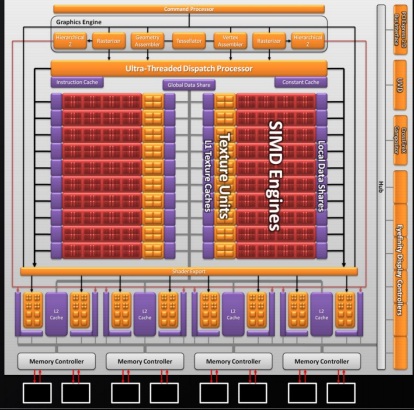Talking numbers
Talking numbersThe table shows that HD 5870 generally provides 2x improvement in most performance-critical areas. An 850MHz engine/shader clock combines to offer 2.72TFLOPs of single-precision performance or 544GFLOPs (one-fifth speed) of double-precision throughput, which is significantly higher than any other graphics card available today - be it single- or dual-GPU.
Texturing is commensurately increased on both 5-series cards, but keeps the 20:1 SP-to-texture-unit ratio intact from the 4-series cards. Gigapixel and Gigatexel fillrates are suitably high, clearly.

Block diagram of Radeon HD 5870
Moving on down, in architecture terms, the render backends have been increased from 16 to 32, as well as bumping up Z/Stencil and AA resolve up by 2x, to better handle the post-processing antialiasing and anisotropic filtering work.
Significant card-accessible memory bandwidth is needed to feed the ROPs (render backends). AMD's engineers have stuck to the 256-bit bus present on the 4K series, presumably for cost reasons, but have bumped up the GDDR5's memory speed to an effective 4.8GHz on the HD5870 - the highest we've seen on a consumer card - and 4.0GHz on the HD 5850.
Whilst we can see that this is an improvement over older single-GPU Radeons, the 153.6GB/s may become the limiting factor once the load is ratcheted-up by running at ultra-high resolutions, say 2,560x1,600. As a comparison, the dual-GPU Radeon HD 4870 X2 has a potential 230GB/s on tap, split over two GPUs. What's more, most Radeon HD 5870 cards will ship with a 1,024MB frame-buffer, to keep costs down, which may combine with the relatively low bandwidth to limit high-resolution performance.
General improvements
Sprucing up the GPU's internal communication, bandwidth between L1 and L2 texture caches has been increased from 384GB/s to 435GB/s, and up to 1TB/s from 500GB/s from L1 to texture filters. The memory-to-L2 speed is defined as the card's bandwidth, that is, 153.6GB/s.
The L2 cache, designed to eradicate cores in the SIMD engines from grabbing the same texels, is boosted from 64KB to 128KB, per memory-controller.
Keeping it cool
GPU engineers are acutely aware that adding additional performance resources inextricably leads to more heat. In view of the architecture's obvious potency, we're impressed with AMD-provided figures for board power - claiming 188W under full load and, tellingly, only 27W when idling.
The idle-power of Radeon 4K cards represented the Achilles Heel for the design, as shown in numerous partner-card reviews undertaken at HEXUS.
In fact, we view the idle-power statistic as being more important than load, simply because the GPU, in most cases, is in an idle state for a longer period of time.
High-level summary
So the $399 Radeon HD 5870 card is bigger, wider, faster, and more-efficient than any other single-GPU that AMD has produced before. How does it compare against the competition? We're glad you asked.









